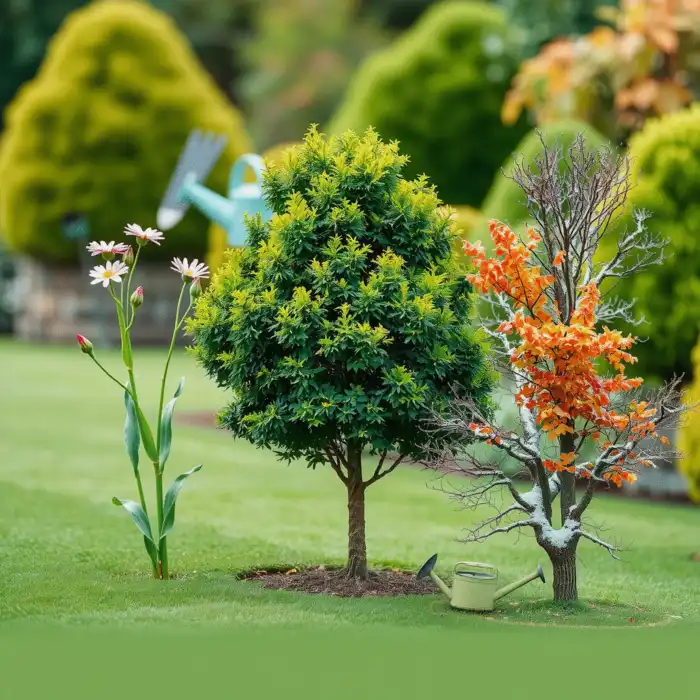Seasonal Tree Care for Gardens

The health of our gardens is intricately tied to the care we provide our trees, yet many still overlook the seasonal nuances required to maintain a thriving ecosystem. As we explore the relationship between seasonal tree care and sustainable gardening practices, consider this: the simple act of nurturing your trees can lead to profound changes in your community and environment.
What You Will Learn
- The significance of seasonal tree care in fostering a vibrant ecosystem and enhancing garden beauty.
- Eco-friendly practices such as using organic fertilizers and implementing integrated pest management to support tree health.
- Seasonal care tips that align with the natural rhythms, from planting in spring to protecting roots in winter.
- The role of arboriculture in improving biodiversity, air quality, and reducing urban heat.
- Strategies for engaging your community through initiatives like tree planting events and educational workshops.
- The importance of collaboration with local nurseries and gardening clubs to enhance resource availability and knowledge sharing.
- Ways to promote urban forestry and community gardening, ensuring inclusivity and advocacy for green spaces in urban planning.
Seasonal Tree Care Practices for Sustainable Gardens
Understanding how seasonal care contributes to a thriving garden ecosystem can enhance tree health and environmental wellness. Visualizing these seasonal practices helps highlight their importance.
Spring
Focus on planting and rejuvenation. This is the time to prune and plant new species!
Summer
Ensure your trees are well-watered and mulched to retain moisture during the heat.
Fall
Fertilize and prepare your trees for the upcoming winter challenges.
Winter
Protect tree roots and inspect for any signs of pests or diseases.
Understanding the Importance of Seasonal Tree Care for Sustainable Gardens
Have you ever thought about how our trees change with the seasons? Just like our gardens, they go through cycles, and understanding these changes is key to nurturing a vibrant ecosystem. At Timber & Thrive, we believe that *seasonal tree care* is not just about maintenance; it’s about creating a harmonious relationship with nature that paves the way for sustainable gardening.
Every season brings unique challenges and opportunities for tree care. By adapting our maintenance practices to the rhythm of nature, we can ensure that our plants thrive all year round. This approach not only enhances the beauty of our gardens but also contributes to the overall health of our environment. So, let’s dive into some eco-friendly practices that can make a real difference!
One crucial aspect to consider is sustainable tree care practices, which ensure long-term health and environmental benefits.
Emphasizing Eco-Friendly Practices in Tree Maintenance
When it comes to tree care, *eco-friendly practices* should always be at the forefront. These practices help reduce our carbon footprint while promoting biodiversity. Here are some key practices to incorporate into your tree care routine:
- Use organic fertilizers: They nourish the soil without harming beneficial organisms.
- Implement integrated pest management: This reduces the reliance on harmful chemicals, focusing instead on natural predators.
- Practice mindful pruning: Only prune when necessary to minimize stress on the tree.
By prioritizing these practices, we not only care for our trees but also contribute to a thriving ecosystem. It’s a win-win for our gardens and the local wildlife!
FAQs About Seasonal Tree Care
- Why is seasonal tree care important?
- Seasonal tree care helps address the unique challenges and opportunities that each season presents, ensuring trees thrive year-round.
- What are some eco-friendly practices for tree maintenance?
- Eco-friendly practices include using organic fertilizers, implementing integrated pest management, and practicing mindful pruning.
- How does arboriculture contribute to sustainable gardening?
- Arboriculture enhances biodiversity, improves air quality, and reduces urban heat through careful tree cultivation and management.
- How can I engage my community in sustainable tree care?
- You can engage your community through tree planting events, workshops, and by fostering collaboration with local nurseries and gardening clubs.
- What is the role of urban forestry in promoting sustainable gardens?
- Urban forestry maximizes green spaces in urban areas, enhancing the aesthetic and ecological value of the community.
How Seasonal Care Contributes to a Healthy Garden Ecosystem
Seasonal care is vital for the *health of your garden ecosystem*. Each season presents its own set of needs that, when addressed, can lead to stronger trees and healthier soil. Consider these seasonal tips:
- Spring: Focus on planting and rejuvenation. This is the time to prune and plant new species!
- Summer: Ensure your trees are well-watered and mulched to retain moisture during the heat.
- Fall: Fertilize and prepare your trees for the upcoming winter challenges.
- Winter: Protect tree roots and inspect for any signs of pests or diseases.
Engaging in seasonal care not only supports the trees but also fosters a resilient garden that can withstand environmental stresses. Think of it as building a strong foundation for future growth!
To further enhance your garden, consider choosing native trees for planting, which are well-suited to the local environment.
The Role of Arboriculture in Sustainable Gardening
Arboriculture plays a crucial role in creating sustainable gardens. It involves the careful cultivation and management of trees, ensuring they flourish in our landscapes. For us at Timber & Thrive, arboriculture means more than just planting trees; it’s about fostering a connection between people and nature.
Here are some ways arboriculture contributes to sustainability:
- Enhances biodiversity: Well-managed trees provide habitats for various wildlife species.
- Improves air quality: Trees absorb pollutants and produce oxygen, making our environment healthier.
- Reduces urban heat: Tree canopies can lower temperatures in urban areas, creating more comfortable spaces for communities.
By incorporating proper arboriculture techniques into your gardening practices, you’re not only caring for your trees but also supporting the ecosystem as a whole. Let’s work together to cultivate a greener future!
Quick Summary
Here's a brief recap of the key points discussed so far:
- Understanding seasonal tree care is essential for nurturing a sustainable garden ecosystem.
- Eco-friendly practices like using organic fertilizers and mindful pruning enhance tree health and biodiversity.
- Engaging your community through gardening initiatives and partnerships can amplify sustainable practices and foster a sense of belonging.
Engaging Your Community in Sustainable Tree Care Practices
Building a vibrant and sustainable garden extends beyond our individual efforts. At Timber & Thrive, we believe that engaging your local community can significantly amplify the impact of sustainable practices. By working together, we can foster a deeper appreciation for trees and a collective responsibility for their care. This can transform our neighborhoods into lush, green spaces, ultimately benefiting the environment and our well-being.
One way to encourage community involvement is through organized gardening initiatives. Consider hosting events like tree planting days or workshops focused on eco-friendly practices. These gatherings not only provide hands-on learning experiences but also help cultivate a sense of camaraderie among participants. Through shared efforts, participants can witness the tangible results of their work, which can inspire future actions. So, are you ready to rally your neighbors?
- Organize tree planting events in local parks.
- Host workshops on sustainable gardening techniques.
- Encourage community members to adopt a tree in their area.
Encouraging Local Involvement in Gardening Initiatives
Getting people involved starts with making sustainable gardening accessible and enjoyable! Why not create a community garden where everyone can pitch in? This space can serve as a hub for education and collaboration, where residents learn about tree care while nurturing the environment. Plus, it’s a fantastic way to build relationships and foster a sense of belonging in the community.
Additionally, consider engaging schools and youth groups. Children are often eager to learn and participate, and involving them in tree care can instill a lifelong appreciation for nature. Hosting school field trips or partnering with local educators to create gardening curriculums can have a lasting impact. Together, we can cultivate future environmental stewards!
- Establish a community garden project.
- Partner with schools for educational programs.
- Create a volunteer group dedicated to local tree care.
Partnering with Local Nurseries and Gardening Clubs
Collaboration is key to enhancing your community’s engagement in sustainable practices. Partnering with local nurseries can provide valuable resources and expertise for your efforts. They can offer guidance on selecting the right native species for your area or even contribute supplies for gardening initiatives. At Timber & Thrive, we often work closely with local growers to ensure our community has access to the best resources.
Gardening clubs also play a crucial role in spreading awareness about tree care. Organizing joint events and workshops with these clubs can create a larger platform for sharing knowledge and experiences. Together, we can engage more people in the conversation about sustainability and help them discover the joys of tree care!
- Collaborate with local nurseries for resources.
- Host joint events with gardening clubs.
- Share knowledge through community newsletters.
For additional guidance, check out nurturing trees for healthier growth.
Promoting Urban Forestry and Community Gardening
Urban areas often have untapped potential for greenery, and promoting urban forestry can help maximize these spaces. Simple initiatives, like planting trees along streets or in vacant lots, can enhance the aesthetic and ecological value of the community. By raising awareness about urban forestry, we can inspire residents to advocate for greener practices and the importance of trees in our cities.
Community gardening initiatives should also aim to include diverse groups. This diversity enriches the gardening experience and ensures multiple perspectives on sustainable practices. By reaching out to various demographics, we can create inclusive spaces that empower everyone to contribute. Let’s make sure our gardens reflect the beauty of our diverse communities!
- Advocate for green spaces in urban planning.
- Host community gardening days open to all.
- Celebrate local gardening successes through events.
Recap of Key Points
Here is a quick recap of the important points discussed in the article:
- Emphasize Eco-Friendly Practices: Incorporate organic fertilizers, integrated pest management, and mindful pruning into your tree care routine.
- Seasonal Care is Essential: Address seasonal needs—planting in spring, watering in summer, fertilizing in fall, and protecting roots in winter.
- Engage Your Community: Organize tree planting events, workshops, and community gardens to involve local residents in sustainable practices.
- Collaborate with Local Resources: Partner with nurseries and gardening clubs to share knowledge and resources for effective tree care.
- Promote Urban Forestry: Advocate for green spaces in urban planning and ensure community gardening initiatives are inclusive.



